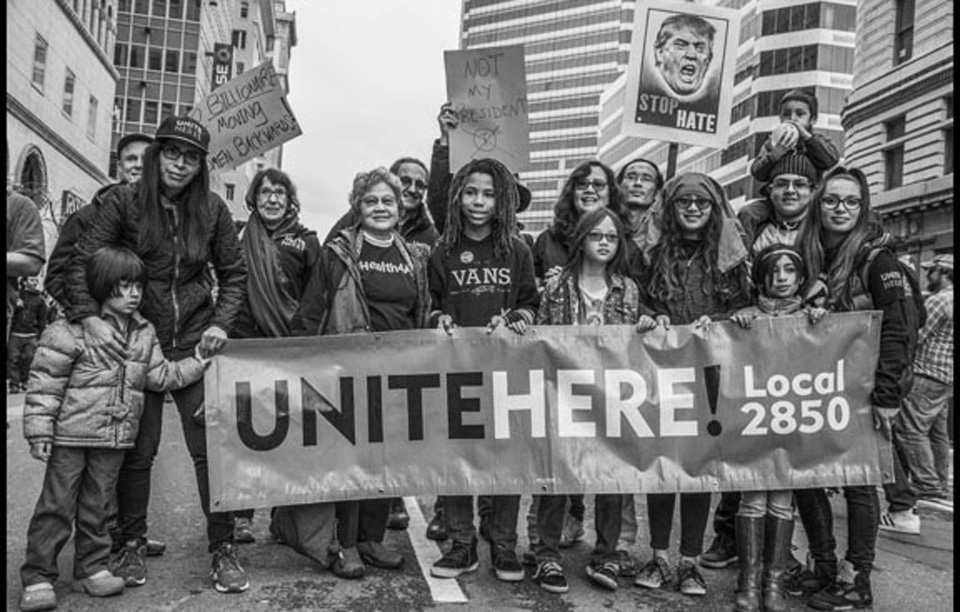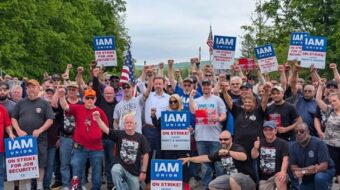
Sanctuary churches. Sanctuary schools. Sanctuary cities.
Sanctuary workplaces?
Albeit far from its intentions, the Trump administration has put the idea of sanctuaries on steroids — spaces free from the threat of raids and deportations. As immigrant workers, unions and their allies look for creative ways to counter anti-immigrant onslaughts, they’re adopting the sanctuary framework to deal with the dangers faced on the job.
This is not just a recent response to administration threats of increased enforcement. Immigrant workers have been battling jobsite raids and firings for many years, seeking ways to prevent la migra (immigration agents) from using their employment to sweep them into the enforcement net. Says Wei-Ling Huber, president of UNITE HERE Local 2850, the hotel union in the East Bay area of northern California, “When we go to work, we should be valued for the contributions we make, and we should be able to do our jobs free from fear of deportations.”
Those contributions should be obvious. One in every ten workers in California is undocumented. So are over half the nation’s farm laborers and 9 percent of its restaurant workers.
In April, Huber’s union went before the Oakland City Council, asking for a policy that would protect immigrants on the job. The council passed a resolution, noting it has been a “City of Refuge” since the anti-apartheid movement of the mid-1980s, a policy reaffirmed last November, just days after Trump’s election. “The City Council … calls upon all employers to establish safe/sanctuary workplaces where workers are respected and not threatened or discriminated against based on their immigration status,” the measure stated.
Local 2850 wanted the statement as a way to define public policy, but actual implementation of an enforcement-free workplace requires more than resolutions. Ten years ago, the union headed a fight in next-door Emeryville, when the Woodfin Suites, a hotel in the southern California-based chain, fired 12 immigrant women housekeepers. Emeryville had just passed a living-wage ordinance for hotel employees, and at the Woodfin Suites workers demanded its enforcement. The hotel accused the 12 women of not having legal immigration documents, and protests over the retaliatory firings went on for four years. Eventually the company had to pay several hundred thousand dollars in back pay. In the process, the Emeryville City Council became committed defenders of the housekeepers.
Moving further toward making the sanctuary workplace a reality, Local 2850 began negotiating protections into union contracts. The union is trying to make one key provision a standard, which cautions that “Should a federal immigration agent or a Department of Homeland Security agent demand entry into the Employer’s premises or the opportunity to interrogate, search or seize the person or property of any employee, then the Employer shall immediately notify the Union by telephone to the union’s office. Except as required by law, the Employer shall not permit the agent(s) to enter the premises without a valid warrant.”
The contract prohibits retaliation against workers because of their immigration status. Once the hotel accepts the documents provided by workers when they’re hired, it can’t go back later and use the government’s E-Verify database to revisit their immigration status.
The need for this was evident in a recent change in one hotel’s ownership, when the new owners wanted all the employees to submit new evidence of their legal status. The workers banded together and refused, thus protecting anyone who might have trouble doing so. The company backed down, and everyone went back to work. In San Francisco, when another boutique hotel chain changed hands, UNITE HERE Local 2 mobilized community pressure to stop the new owners from similarly re-verifying workers’ immigration status.
At issue is a provision of the 1986 Immigration Reform and Control Act, which, for the first time in US history, prohibited employers from hiring undocumented workers. The law required employers to verify workers’ immigration status when they are hired, and led to the creation of the huge E-Verify database of all workers’ immigration status.
After 1986, undocumented workers could no longer apply for Social Security numbers. Since then, to get hired, workers without papers have made up numbers or used those of other people. Employers deduct contributions from their paychecks for Social Security — about $13 billion/year. But workers without papers can’t collect the benefits the contributions pay for. In the meantime, the government uses the discrepancy in numbers as a tool for immigration enforcement.
Another purpose, therefore, of the sanctuary workplace is to prevent Immigration and Customs Enforcement (ICE) agents from using Social Security numbers to identify undocumented workers and force employers to fire them. In some cases, ICE (and its predecessor, the Immigration and Naturalization Service) have even sent workers to federal prison, charging that providing a bad Social Security number constitutes “identify theft.”
In Local 2850’s contract language, hotels can’t terminate workers simply because Social Security questions their numbers — a protection won by San Francisco’s Local 2 several years ago. And if undocumented employees gain legal status, and a new valid number, the company must recognize their continuing seniority and job rights. Workers are even given a paid holiday on the day they’re sworn in as new citizens.
The strategy used in the Oakland resolution, and unions’ contract language, has also become the basis of a bill introduced into the California state legislature, at the initiative of the SEIU United Service Workers West — the union for janitors, security guards and airport workers. AB 450, the Immigrant Worker Protection Act, requires employers to ask for a judicial warrant before granting ICE agents access to a workplace. It prohibits employers from sharing confidential information, like Social Security numbers, without a court order. This bill also says employers must notify the state Labor Commissioner if ICE demands employee information.
United Service Workers West, like the hotel unions, also has a history of fighting workplace immigration raids and firings. In 2011 Los Angeles janitors sat down in city intersections to protest immigration-based firings by Able Building Maintenance. The union fought similar firings in Stanford University cafeterias, and among custodians in the Silicon Valley buildings of Apple and Hewlett-Packard. UNITE HERE members in San Diego mounted a hunger strike outside the Hyatt Hotel over the same issue. Over 200 Molders Union members in Berkeley at the Pacific Steel foundry fought firings for almost a year.
A number of unions are beginning to train workers to act together on the job to resist raids and firings. This spring, in a session organized by the International Longshore and Warehouse Union (ILWU), Filipino Advocates for Justice and several other groups, workers acted out scenarios that used job action to protect each other. ILWU members from a local recycling company, Alameda County Industries, dramatized their own strike three years ago, when they stopped work to keep the company from firing employees for not having papers. In another skit, they suggested that workers take action to demand that their boss bar ICE agents from the workplace, if they have no court order. Other unions described their experiences over the past decade in organizing workers to fight off raids and firings.
As a result of this activity, unions with a significant membership of immigrants, and a history of fighting to defend them, were very visible in May Day’s “Day Without Immigrants” marches. Many had participated in the crowds that shut down airports in January, in response to Trump’s attempted ban on migrants and travelers from Muslim countries. As workers did in 2006 — when marches protested a bill in Congress to make undocumented status a federal felony — marchers this year protested similar threats from Attorney General Jeff Sessions.
In a highly publicized event in April on the Arizona-Mexico border, Sessions told the press that enforcement would now prioritize identity theft, among other factors. “And it is here that criminal aliens, and the coyotes, and the document-forgers seek to overthrow our system of lawful immigration,” he announced. By employing phrases like “identity theft” and “document-forgers,” Sessions once again treats giving a bad Social Security number to an employer as a criminal offense. The Pew Hispanic Center estimates that over 8 million undocumented people are in the workforce, working under bad numbers, making them potentially subject to these charges.
Anger over workplace enforcement actions has a long history in California. One of the first battles took place at the Kraco car radio factory in the early 1980s. In an action that preceded the sanctuary debate by over 30 years, workers joining the United Electrical Workers stopped the plant to force the owner to deny entry to immigration agents. Later that decade, the Molders Union Local 164 in Oakland joined the Mexican American Legal Defense and Educational Fund in suing the Immigration and Naturalization Service over its practice of having agents bar the doors of factories, holding workers prisoner, and then interrogating them and detaining those without papers. The case went to the US Supreme Court, which found the practice unconstitutional.
In the Day Without Immigrants actions, unions and immigrant rights organizations sought to tap into this history, and linked the sanctuary workplace to the enforcement of labor rights in general. Sixty workers from Oakland and Emeryville hotels left their jobs and picketed the site of a proposed new hotel that has refused to guarantee workers’ freedom to organize. After tearing down a symbolic “Trump wall,” they joined the main May Day march.
In New York City, immigrant workers at one of the world’s largest suppliers of photography materials, B&H Photo Video, struck for the day, protesting a plan to relocate 330 jobs from Brooklyn, New York, to Florence Township, New Jersey. Workers have been trying to negotiate a union contract with the help of the Laundry Workers Center and the United Steel Workers, and they have accused the company of using the move to punish workers for their union support.
A thousand people marched in Yakima, in the heart of central Washington’s apple orchards. Most were farm workers who had taken off work for the day, including a large contingent from the Chateau Ste. Michelle winery who belong to the United Farm Workers. Some workers were released for the day by their employers at local packing sheds. Mike Gempler, executive director of the Washington Growers League, criticized the Trump administration, calling officials like Sessions “very zealous.” Trump’s enforcement program, he said, “will economically destroy much of the agriculture industry, and I think we will also end up treating people unfairly.”
And a week after May Day, the country’s newest farm worker union, Familias Unidas por la Justicia, marched 17 miles from Lynden to Bellingham in Washington. In addition to protesting Trump’s anti-immigrant policies, farm workers demanded that Washington grower Sakuma Brothers Farms sign a union contract. The union mounted a three-year boycott of Driscoll’s Berries, which markets the berries they pick for Sakuma. Combined with strikes in the fields, the boycott forced the grower to agree to a union election, won by workers last September. Their march coincided with a hunger strike by immigrants held in Tacoma, Washington’s Northwest Detention Center. Familias Unidas por la Justicia has a history of support for the center’s detainees, in part because they are forced to do all the work at the privately-run prison (except guarding themselves), at an illegal wage of $1 a day.
In the mobilizations around May Day, support grew on a national level for immigrant workers facing raids. Four unions (Communications Workers of America, Amalgamated Transit Union, National Nurses United and the United Electrical Workers) sent out a letter urging workers and labor activists to participate in the Day Without Immigrants strikes and marches.
“As leaders of the unions who supported Bernie Sanders for president, we refuse to go down that road of hatred, resentment and divisiveness,” they declared. “We will march and stand with our sister and brother immigrant workers against the terror tactics of the Trump administration.”
Over a month later, the Trump administration appears strangely reluctant to implement Sessions’ threats on a wide scale in the nation’s workplaces, but organizers are far from declaring victory. According to Agustin Ramirez, an organizer for the International Longshore and Warehouse Union in California, “The threats from Trump tell us this is coming. We just don’t know when.”











